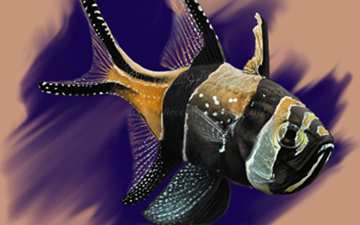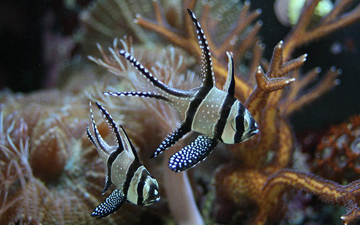 Pteropogon kauderni
Pteropogon kauderni
8 POINTS
• Pteropogon kauderni has a MOVE of 2.
Warm
The Banggai cardinalfish (Pterapogon kauderni) is a small tropical cardinalfish (family Apogonidae). This attractive fish is popular in the aquarium trade. It is among the relatively few marine fish to have been bred regularly in captivity, but significant numbers are still captured in the wild and it is now a threatened species.[1] This species is […]
read more
The Banggai cardinalfish (Pterapogon kauderni) is a small tropical cardinalfish (family Apogonidae). This attractive fish is popular in the aquarium trade. It is among the relatively few marine fish to have been bred regularly in captivity, but significant numbers are still captured in the wild and it is now a threatened species.[1]
This species is restricted to the Banggai Islands of Indonesia.[2]This species has an extremely limited geographic range (5,500 km²) and small total population size (estimated at 2.4 million).[3] The Banggai cardinalfish is composed of isolated populations concentrated around the shallows of 17 large and 10 small islands within the Banggai Archipelago. A small population also occurs off Central Sulawesihow to get an annulment
>, within Luwuk harbor. One additional population has become established in the Lembeh Strait (North Sulawesi), 400 km north of the natural area of the species distribution, following introduction by aquarium fish traders in 2000.[3]
(From Wikipedia, April 23, 2010)
– – –
Common around the jetty, in silty sand bottoms with seagrass (Enhalus acoroides). Associated with Diadema setosum, the long-spined sea urchins. Individuals of 2 to 60 hover directly above the urchins, with the younger ones about 2-3 cm SL staying closer to the urchins. The fish retreat among the spines when threatened. Probably feed on small benthic and planktonic crustaceans at night. Male incubates the eggs until hatching; the large egg about 2.5 mm in diameter, with the young remaining within the mouth cavity for undetermined period after hatching (Ref. 9936, 48635). Newly hatched larvae have no planktonic period (Ref. 35886). Juveniles also use anemones for protection (Ref. 45560, 48635). Has been reared in captivity (Ref. 35417).
(From EOL via fishbase.org, April 23, 2010)
zp8497586rq





